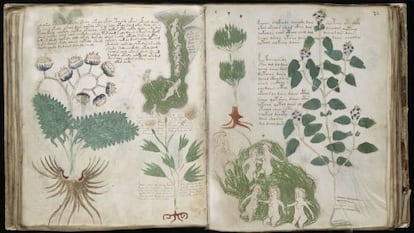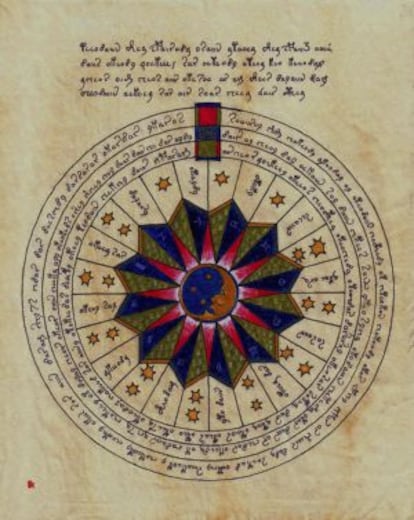Passing on the secrets of the world’s most mysterious book
A Spanish publisher has been chosen to create a facsimile of the ‘Voynich Manuscript’

For the last century, the Voynich Manuscript, a renaissance codex of 234 pages measuring 22.5 by 16 centimeters and written in an unknown language, has resisted all attempts to fathom its mysteries.
Over the years a number of theories about the volume, which is now kept in Yale University’s Beinecke Library, have been proposed: it has variously been identified as a botanical guide to non-existent plants, a cosmological treatise, a cabbalistic treatise, a war story, a catalogue of magic potion recipes, a contraceptive guide, an extraterrestrial diary, a study of the transmutation of the philosopher’s stone, and even the work of elves. Some have also said it is simply a very clever hoax and that its content is gibberish.
The manuscript has been identified as a guide to non-existent plants, a cosmological treatise, a contraceptive guide, and even the work of elves
The latter theory has largely been discarded, in part after it was analyzed on the basis of Zipf’s law, which states that the most frequent word in a text will occur approximately twice as often as the second most frequent, three times as often as the third most frequent, and so on. The text has been dated to the first half of the 15th century, a time long before any understanding of Zipf’s law existed.
The Voynich Manuscript was discovered in 1912 by a Lithuanian bookseller name Wilfrid Wojnicz at the Villa Mondragone, a mansion on the outskirts of Rome that once belonged to the Borghese family. Nobody knows who wrote or illustrated it, what its purpose was, or even what language it is written in. Some have suggested a link to Sanskrit or other Eastern languages, or that it is an early example of an invented language, a kind of precursor to Esperanto. It could be a cipher, but if it is, not even the US military’s code breakers have been able to crack it.
Last year, Stephen Bax of the University of Bedfordshire in the UK, announced that he had managed to decipher 14 symbols from it.

Now, from next year, a facsimile edition of the work is to be made available through Spanish publisher Siloé.
Juan José García and Pablo Molinero founded Siloé two decades ago, and since then have published around 30 facsimiles, mainly from the medieval period.
“We first heard about the Voynich Manuscript in 2005 and immediately knew we wanted to copy it,” says Juan José García. “What really excited us about it was that it is one of the most requested books in the world for exhibitions, so it’s much simpler for an institution like the Beinecke Library, rather than having to loan the codex out all the time, to be able say that there is an exact replica that a Spanish publisher has printed that you can use. This was a good argument for persuading them to give us the project.”
Siloé is based in the northern city of Burgos, where much of its collection of facsimiles, which include the Codex Calixtinus of Salamanca University, the Book of Hours of Louis de Laval, The Life and Miracles of St Louis, the Cartularies of Valpuesta, and the Geneva Beatus, can be seen and bought in the privately run Fadrique de Basilea museum.
Siloé, which has been awarded 12 prizes for its facsimiles by the Spanish Ministry of Culture, has been negotiating with the Beinecke Library for the last two years, says García: “These types of decisions aren’t taken overnight: US universities like to think things over properly.”
The book could be a cipher, but if it is, not even the US military’s code breakers have been able to crack it
In February, García and his team will travel to the Beinecke Library in New Haven, where, under the watchful eye of a specially assigned security guard, they will begin preparing their facsimile edition of the Voynich Manuscript. “This kind of security is quite normal,” jokes García. “When we cloned the Westminster Bestiary, for example, we had to provide safety certificates for the plugs we used on the lights to illuminate the manuscript – you have to understand that a dodgy light bulb could set fire to an abbey or library!”
Creating a facsimile of a medieval codex is a complicated and difficult process, and there is no room for shortcuts, explains García: “We work on each page separately, and everything is done by hand, page by page, so that the book has the same aged shape as the original. We also have to remember that we are dealing with a living material that has been inert for around 600 years, having been through different temperatures, humidity, aridity, exposed to light or kept in darkness. These books tend to be dehydrated to varying degrees, so that in some parts they might looked scorched… and when you turn a page there’s a kind of crackling sound. All of this has to be captured in the facsimile, and it’s technically very complex.”
The Voynich Manuscript, like all Siloé’s projects, comes with its own peculiarities: “It is written on vellum, which is unborn animal skin, from the fetus of a lamb or calf, the softest and most delicate material you can imagine; what’s more, there are pages that open, unfold, multiply… and that makes it even more technically difficult.”
Paradoxically for a 600-year-old book, the manuscript has the power to take us back to our childhood: because it cannot be read, it can only be looked at, in the same way that a child looks at a comic or picture book before learning to read. So far, nobody has been able to read the Voynich Manuscript, but perhaps now that a facsimile will soon be available, one day, somebody will unlock its mysteries.
Tu suscripción se está usando en otro dispositivo
¿Quieres añadir otro usuario a tu suscripción?
Si continúas leyendo en este dispositivo, no se podrá leer en el otro.
FlechaTu suscripción se está usando en otro dispositivo y solo puedes acceder a EL PAÍS desde un dispositivo a la vez.
Si quieres compartir tu cuenta, cambia tu suscripción a la modalidad Premium, así podrás añadir otro usuario. Cada uno accederá con su propia cuenta de email, lo que os permitirá personalizar vuestra experiencia en EL PAÍS.
¿Tienes una suscripción de empresa? Accede aquí para contratar más cuentas.
En el caso de no saber quién está usando tu cuenta, te recomendamos cambiar tu contraseña aquí.
Si decides continuar compartiendo tu cuenta, este mensaje se mostrará en tu dispositivo y en el de la otra persona que está usando tu cuenta de forma indefinida, afectando a tu experiencia de lectura. Puedes consultar aquí los términos y condiciones de la suscripción digital.









































